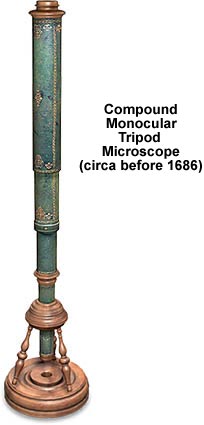Compound Monocular Tripod Microscope
The body of this microscope is 24 inches when fully extended and 16 inches when closed. John Mayall obtained this microscope in France for Colonel Billings in 1887, where it was reported to have been in the possession of one family since early in the 1700's. The model featured below was redrawn from photographs of the original microscope, which is part of the Billings microscope collection at Walter Reed Army Hospital in Washington DC.

Covered with green vellum and gold stampings, the body of this beautiful microscope is fashioned from pasteboard and contains three draw tubes. The wooden (probably pear) circular base has three legs that support a turned wood cone socket that secures the body tube. Focusing is achieved by sliding the draw tubes in and out. At the top of the lowest tube is a 7/8-inch diameter field lens, and the draw tube, which carries the eye lens, slides over the body tube, thus varying the distance between the two lenses. The objective is mounted in a wooden fixture that screws into the nosepiece.
BACK TO SIXTEENTH-SEVENTEENTH CENTURY MICROSCOPES
